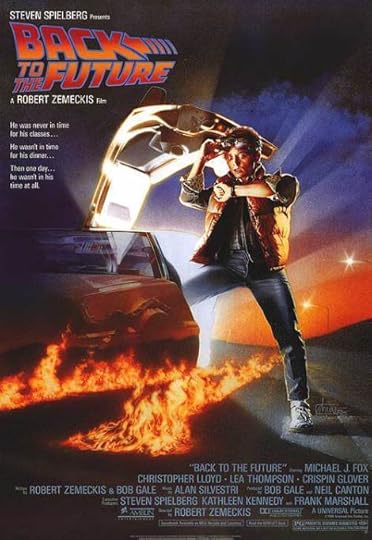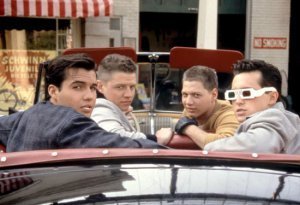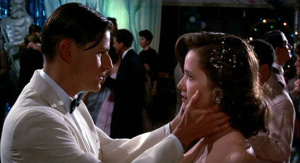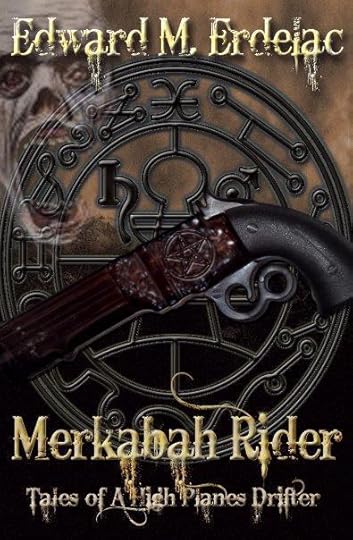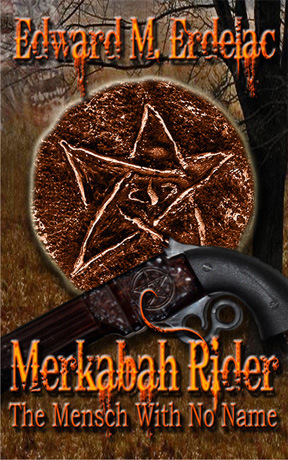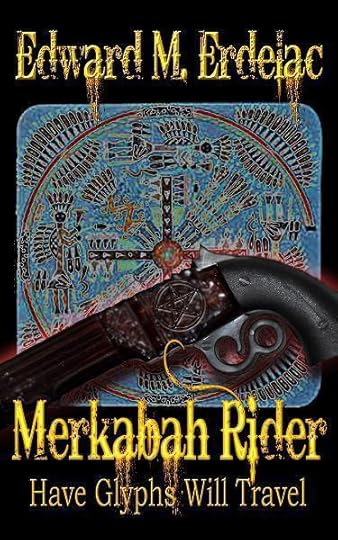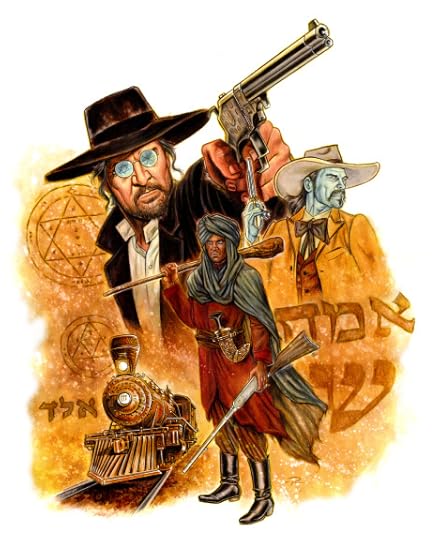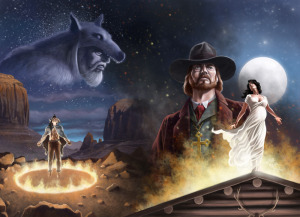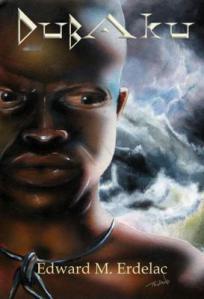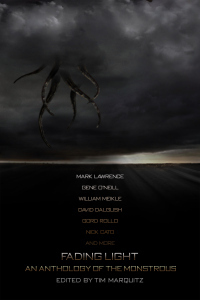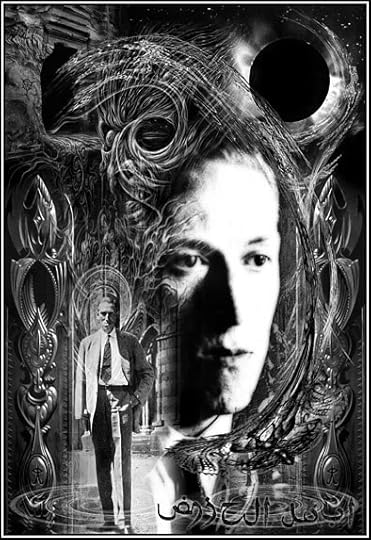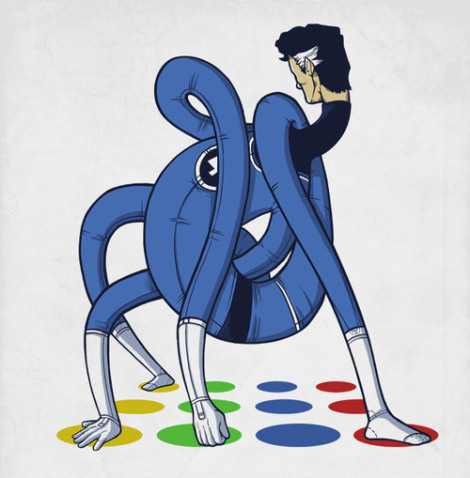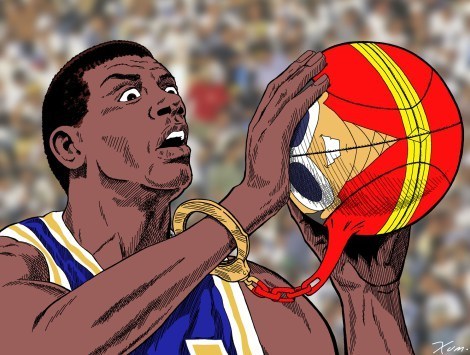Edward M. Erdelac's Blog, page 33
September 27, 2012
DT Moviehouse Review: Back To The Future
Time once more for my blog feature, DT Moviehouse Reviews, in which I make my way alphabetically through my 200+ DVD/Blu-Ray collection (you can see the list right here) and decide if each one was worth the money. Today I take a look at the 80′s classic Back To The Future.
[image error]
(1985) Directed by Robert Zemeckis
Screenplay by Robert Zemeckis and Bob Gale
Tagline: He was never in time for his classes…He wasn’t in time for his dinner…Then one day, he wasn’t in time at all.
What it’s about:
In 1985, high school senior Marty McFly (Michael J. Fox) living with his listless alcoholic mother (Leah Thompson), put-upon, oblivious nerd father (Crispin Glover), and loser siblings, dreams of escaping his hometown of Hill Valley and playing guitar in a rock and roll band. One night Marty’s friend, the eccentric inventor Dr. Emmett Brown (Christopher Lloyd) asks him to videotape his most important scientific experiment, a plutonium charged time machine he has created out of a DeLorean. When an accident occurs that sends Marty back in time in the DeLorean to 1955, he accidentally disrupts his family’s timeline, causing his mother to fall for him instead of his father.
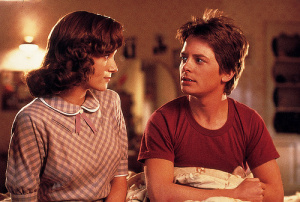
Whoa, this is heavy…
This creates a paradox that will eventually cause him and his brother and sister to cease to exist. He hunts up the 1955 version of Doc to help him return to his own time, and plays a frenetic matchmaker to his parents before he fades out of existence.Why I bought it:
Back To The Future is without a doubt one of the best, most beloved movies to come out of the 80’s. Even if there hadn’t been a pair of sequels, it would remain a popcorn summer classic.
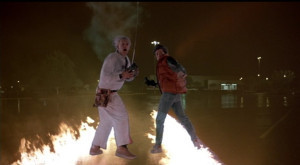 It’s a seamless, lighting-struck-the-clock-tower combination of comedy, romance, adventure and science fiction, with likeable characters and a perfectly constructed script with about as much fat on it as Bruce Lee at the height of his powers.
It’s a seamless, lighting-struck-the-clock-tower combination of comedy, romance, adventure and science fiction, with likeable characters and a perfectly constructed script with about as much fat on it as Bruce Lee at the height of his powers.
In rewatching it, I was delighted by how well crafted the story was. Every single minute element introduced contributes to the whole.
During Marty’s dinner with his 1985 family we are bombarded with important facts in rapid succession – Lorraine describes her first meeting with George and the moment in time when they fell in love, a kiss during a high school dance, George watches the very same episode of The Honeymooners the Baines family will be watching for the first time in 1955 – AND it’s an episode where a character disguises himself as an alien, something Marty will do to motivate his father later on. The woes of his brother and sister are established, so that even with their bare minimum screen time we understand their ultimate reversal of fortune in the end with only a few lines of dialogue. Everything plays out so naturally, we don’t even recognize it as exposition as its happening.
Similarly, Doc shares the story of how he came to be inspired to invent the time machine with Marty, enabling Marty to have the knowledge to earn ’55 Doc’s trust with little physical proof. Everything Marty takes into the time machine (rad suit, Walkman, etc.) comes into play later.
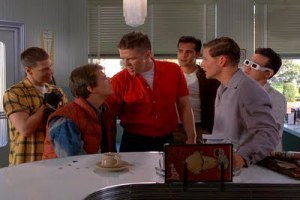 Marty is of course the hub character around which the movie revolves, and Fox was at the top of his game when he took a break from his hit sitcom Family Ties to do BTTF (replacing a miscast Eric Stoltz). Yet he plays a character the polar opposite of ultra-capitalist Young Republican Alex (his character on Family Ties). Marty is very cool and charming, but flawed enough to still be relatable. We first see him blowing out Doc’s massive speaker with his electric guitar in an MTV-esque ‘woe dude’ moment, and then he skateboards all around town, hanging onto the back of a jeep and waving to the ladies’ aerobics class in a classic and tone setting sequence to the tune of Huey Lewis’ hit single ‘Power of Love.’ But the very next time we see Marty pick up his guitar to audition for his own high school dance, he is promptly rejected as being too loud (amusingly, by a disguised and nerded up Huey Lewis). Marty’s fear of rejection and lack of self confidence becomes a lesson he has to learn vicariously through his own father’s romantic woes in the past.
Marty is of course the hub character around which the movie revolves, and Fox was at the top of his game when he took a break from his hit sitcom Family Ties to do BTTF (replacing a miscast Eric Stoltz). Yet he plays a character the polar opposite of ultra-capitalist Young Republican Alex (his character on Family Ties). Marty is very cool and charming, but flawed enough to still be relatable. We first see him blowing out Doc’s massive speaker with his electric guitar in an MTV-esque ‘woe dude’ moment, and then he skateboards all around town, hanging onto the back of a jeep and waving to the ladies’ aerobics class in a classic and tone setting sequence to the tune of Huey Lewis’ hit single ‘Power of Love.’ But the very next time we see Marty pick up his guitar to audition for his own high school dance, he is promptly rejected as being too loud (amusingly, by a disguised and nerded up Huey Lewis). Marty’s fear of rejection and lack of self confidence becomes a lesson he has to learn vicariously through his own father’s romantic woes in the past.
Speaking of George McFly, I can’t imagine anybody but Crispin Glover playing that role. George’s weird, breathless way of speaking (as if it takes a supreme effort for him to say a single thing to anybody) and oddball, un-self conscious (look at the way he dances by himself in a wonderful little shot at the beginning of the Enchantment Under The Sea Dance) body movements inform a sympathetic portrayal of a born outsider who comes in from the cold, eventually finding his own strength and self-confidence in the movie’s most memorable and cheer inducing scene.
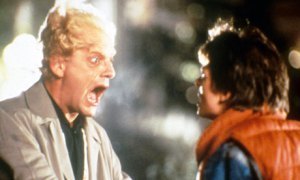 Likewise, Christopher Lloyd brings an infectious, frantic enthusiasm to Doc, the antithesis of the slow talking burn-out character Jim that made him a star on Taxi. You’re taking a chance with a character who is so passionate he literally howls at the sky and dances with unmitigated joy when he realizes he’s finally invented something that actually works. It could easily come off forced and silly, but with Lloyd it doesn’t. He’s the same sort of outsider as George, but with a self-confidence that he instills with Yoda-esque wisdom in Marty (and thus, in a roundabout way, to George too). This makes for a great rapport between Marty and Doc, with Doc acting as kind of a surrogate father (seeing as how 1985 George is such an abysmal failure as a role model, being bullied by Biff even as an adult).
Likewise, Christopher Lloyd brings an infectious, frantic enthusiasm to Doc, the antithesis of the slow talking burn-out character Jim that made him a star on Taxi. You’re taking a chance with a character who is so passionate he literally howls at the sky and dances with unmitigated joy when he realizes he’s finally invented something that actually works. It could easily come off forced and silly, but with Lloyd it doesn’t. He’s the same sort of outsider as George, but with a self-confidence that he instills with Yoda-esque wisdom in Marty (and thus, in a roundabout way, to George too). This makes for a great rapport between Marty and Doc, with Doc acting as kind of a surrogate father (seeing as how 1985 George is such an abysmal failure as a role model, being bullied by Biff even as an adult).
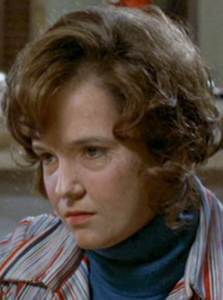 The rest of the cast definitely picks up the slack. Leah Thompson displays a lot of talent going from her boozy and tired 1985 version of Lorraine to her wide-eyed romantic ’55 counterpart. She doesn’t just let the aging makeup do the work, ninety percent of it is in her voice (shown in the scene when Marty wakes up after being hit by his grandfather’s car and his mother’s voice in the dark lulls him into thinking his time jump was all a dream). Then, when Marty alters the timeline, she manages to pull off a changed older Lorraine, still in love with life but more mature.
The rest of the cast definitely picks up the slack. Leah Thompson displays a lot of talent going from her boozy and tired 1985 version of Lorraine to her wide-eyed romantic ’55 counterpart. She doesn’t just let the aging makeup do the work, ninety percent of it is in her voice (shown in the scene when Marty wakes up after being hit by his grandfather’s car and his mother’s voice in the dark lulls him into thinking his time jump was all a dream). Then, when Marty alters the timeline, she manages to pull off a changed older Lorraine, still in love with life but more mature.
Glover also does an admirable job in that respect, altering his way of speaking and toning down the nervousness as adult/author George. When you consider that both actors actually played three different versions of their characters, you have to single out and applaud their work.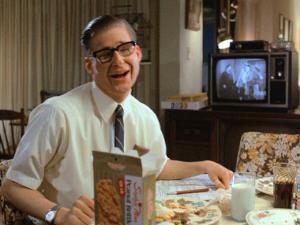
I’ve also got to say something about the very talented and often overlooked Tom Wilson who plays Biff Tannen, George’s (and Marty’s) longtime nemesis. Wilson deftly juggles bonehead comedy and real menace in the character, and like Thompson and Glover, pulls off a humorous turn as an aged, cowed bootlicker who’s got his comeuppance in the final reel (but yet, is still dangerous and conniving – something that comes out in the next installment, which he and the rest of the cast picks up almost perfectly after a four year hiatus).
Finally, there’s the score by Alan Silvestri, who composes an instantly recognizable theme that is as beautifully evocative as anything in Star Wars or the Indiana Jones movies.
Is there anything at all off about Back To The Future? Hardly anything. Claudia Wells, who plays Marty’s girlfriend Jennifer doesn’t ever have a lot to do, it’s true. She’s more a representation of what Marty’s trying to get back to.
The only other thing I would bring up is the Johnny B. Goode sequence. Biff’s gang throws Marty in the trunk of the all black band’s car, and the guitarist cuts his hand jimmying the lock to get him out, forcing Marty to take over lead guitar (because if George and Lorraine don’t kiss during the dance, Marty will still fade away – and he nearly does when that kid from Children Of The Corn cuts in.). After George and Lorraine kiss during ‘Earth Angel,’ the band convinces Marty to place one more tune – something that really kicks.
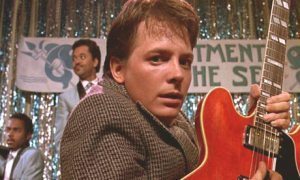 Johnny B. Goode is one of the quintessential early rock and roll songs, and it is very significant that Chuck Berry, an African American, is the guy who did it. In rewatching BTTF, I did have a brief moment’s trepidation at the scene where Marvin Berry holds up the phone to his cousin Chuck as Marty plays, implying that a white kid from 1985 California is the real inventor of rock and roll.
Johnny B. Goode is one of the quintessential early rock and roll songs, and it is very significant that Chuck Berry, an African American, is the guy who did it. In rewatching BTTF, I did have a brief moment’s trepidation at the scene where Marvin Berry holds up the phone to his cousin Chuck as Marty plays, implying that a white kid from 1985 California is the real inventor of rock and roll.
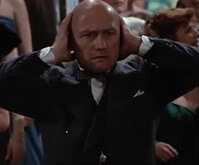
Strickland’s not ready for this.
Other than that, the movie remains a knockout. I watched it with my eight year old and she excitedly asked what was the matter with Marty’s kids in the future and insisted we watch the second and third movies in one sitting (and has since asked to watch them again).
As for me, I saw this movie in the theater with my mom when I was ten years old, and I fondly remember sharing laughs and cheers with her and a packed moviehouse. I imagine a lot of kids took to skateboarding from watching this flick (I tried, but I could never even stand on one of those things). I remember being totally mind blown at the scene where Marty returns early to the mall and sees himself – this was my first exposure to the idea in science fiction of the time travel paradox. I wanted so bad to be as cool as Marty, and to have the same personal triumphs as George.
It’s just a movie that makes the heart soar, makes you appreciate your parents a little more, and is totally on the ball and uncompromising in its setting and story, and yet is flat out fun.
Best bit of dialogue:
In the original unaltered timeline, Doc cons a group of Libyan ‘nationals’ out of the stolen plutonium to power the time machine. The Libyans surprise Doc and Marty on the night of the testing of the DeLorean at the mall and machinegun him to death.
Throughout the movie, Marty wrestles with telling 1955 Doc about his impending death in 1985, even though Doc warns him not to inform him about any future events, pointing out that Marty’s interference in his own continuum has been thus far disastrous.
In a last desperate attempt to save his friend’s life, Marty writes out a warning on diner stationary and seals it in an envelope marked Do Not Open Until 1985. But just prior to leaving 1955, Doc finds the envelope and tears it to pieces.
Marty sets the time circuits for a ten minute early return to personally go and warn Doc, but after the time jump the DeLorean stalls and Marty spends the extra ten minutes running across town to the mall, where he helplessly witnesses the death of Doc a second time. After watching his earlier self jump to 1955 in the time machine, Marty runs down to Doc’s body only to find him very much alive, having reassembled Marty’s yellowed letter with scotch tape and donned a bulletproof vest to save himself.
“What about all that talk about screwing up future events? The space time continuum?” Marty asks.
Doc grins and shrugs.
“Well…I figured…what the hell?”
Best scene:
When I was a kid, the hands down coolest sequence for me was the one where Biff and his gang chase Marty all around the town square on his improvised skateboard. I still get chills when Biff gets Marty hung up on the grill of his car and tries to ram him and Marty runs up on the hood and through the open car, leaping perfectly onto the skateboard as it emerges from underneath the rear of bumper. The musical cue is spot on perfect, the expressions of the actors are great, and the stunt is awesome.
BUT
Seeing the movie again through adult eyes, nothing tops the emotional crescendo of the scene when George punches out Biff in defense of Lorraine.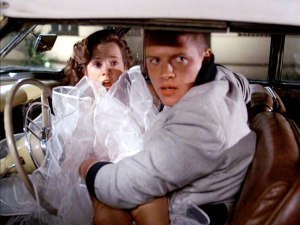
 Wilson is at his darkest and most imposing, glaring up at George from the depths of the car and the ruffles of Lorraine’s dress (“Wrong car, McFly”). Glover shifts masterfully through a range of emotions, beginning with disappointment and fear when he realizes that it’s Biff and not Marty as planned, reluctant resolve (“No Biff, you leave her alone”), terror when Biff bends his arm back, to righteous outrage when he sees Lorraine shoved to the pavement.
Wilson is at his darkest and most imposing, glaring up at George from the depths of the car and the ruffles of Lorraine’s dress (“Wrong car, McFly”). Glover shifts masterfully through a range of emotions, beginning with disappointment and fear when he realizes that it’s Biff and not Marty as planned, reluctant resolve (“No Biff, you leave her alone”), terror when Biff bends his arm back, to righteous outrage when he sees Lorraine shoved to the pavement. 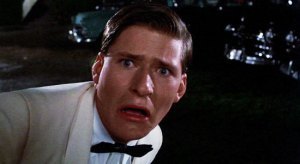 I love that change in his face in the moment before his fist balls up and he slugs Biff into oblivion. Then, that nervous little laugh as he looks with disbelief at his own hand, remembers Lorraine, asks her if she’s alright, and pulls her to her feet.
I love that change in his face in the moment before his fist balls up and he slugs Biff into oblivion. Then, that nervous little laugh as he looks with disbelief at his own hand, remembers Lorraine, asks her if she’s alright, and pulls her to her feet.
Would I Buy it Again? In a heartbeat.
NEXT IN THE QUEUE: Back To The Future Part II


September 25, 2012
Merkabah Rider: Once Upon A Time In The Weird West Preview
What happens in the fourth and final book of the Merkabah Rider series? Read the prologue of Merkabah Rider: Once Upon A Time In The Weird West below.
What’s Merkabah Rider? Read about it right HERE.
In honor of Yom Kippur, The Day Of The Atonement, the holiest twenty six hours in the Judaic calendar (and as loyal readers of the Rider will know, the day in 1882 that the Hour Of Incursion comes upon us), from now until sundown tomorrow (or 6:30 Pacific Time) every reader who comments on this post, I’ll send a free copy of either:
Merkabah Rider: Tales Of A High Planes Drifter
Merkabah Rider 2: The Mensch With No Name
or Merkabah Rider 3: Have Glyphs Will Travel
- your choice of title, your choice of format (pdf, epub or mobi). Just tell me below in the comments section (one per comment/visitor).
And if you’re a Luddite like me, send an email to emerdelacATgmailDOTcom with Yom Kippur as the subject line.
Then at 6:30pm on Wednesday night (the 26th), I’ll draw a random recipient’s name from the old ten gallon yarmulke. The winner gets a signed copy of Merkabah Rider: Tales Of A High Planes Drifter AND Merkabah Rider 2: The Mensch With No Name.
Without further to-do, here’s the first pages of MR IV:OUATITWW – AND a first gander at the cover by (dare I say it? I do) the magnificent Pat Carbajal, who will also be providing eight (count ‘em) eight bee-you-tiful interior black and white illustrations.
Prologo
The diggers, drunks and saddle tramps all, nominally paw the earth with spades, knowing not why, only that they are paid well and in gold to do very little.
The tracklayers pause as the swing gang reaches the shade of the Huachuca Mountains, and in the seventh hekhalot the dread angel Metatron, once Enoch, dips its bright pen in the inkwell of eternity. Three descend upon the earth, perhaps for the final time.
In the Dreamlands, the Thunder of God seeks the Other to no avail.
In the lowest region of hell, in the marble city of Pandæmonium, Lucifer fidgets on his throne and sets aside the Damnatus Damnateum as Temelechus strokes the hide of Nehema with a glowing iron flail. She shrieks her gratitude.
Simultaneously, a man of God and a man of science each realize that the stars will soon be right and snap their respective books closed.
At midnight, just outside Kearney, Missouri, the squeaking wheels of a bone laden wagon cease their revolution and a dozen black garbed figures bearing shovels and prybars slink toward a grave, where grass has not yet sprouted over the body of Jesse James.
In the bleak fields of the Jornada Del Muerto, a preacher of wavering faith, strung with canteens and waterskins, bows his head and bends his iron legs, his frightened, murmuring prayers lost in a hiss of venting steam.
A master engraver pauses, surveying his final, terrible work. He wipes the sweat and tears from his eyes, and wishes he had listened to his wife. Then he puts his chisel to a gilded smokebox door.
A blue skinned killer passes a cracked leather map case across a polished desk to the delight of a pair of madmen.
A girl notices a stranger’s smile spread across her father’s face.
The thing that calls itself Adam Belial in this universe howls in wild triumph and the whole of Creation shudders.
In the dense void beyond, gibbering things ripple with excitement and colossal shapes turn in their precarious fluid slumber.
An engorged, tame beast stirs to the trill of distant piping, remembers what it once was, and strains against its chain.
An old, old gentleman in a blue suit and top hat places a pressed lilac on a smoldering mountain pyre of one of the thirty six hidden saints and heads west, where a dreadful infant and a one armed soldier wait within a carved vardo, and a pale, scar-eared onnager vies with a team of ornery camels for a space to graze.
A burned woman counts the hours.
And somewhere the Rider meets The Chief Angel of Death…
-Hasta pronto!


September 19, 2012
An Excerpt From Terovolas
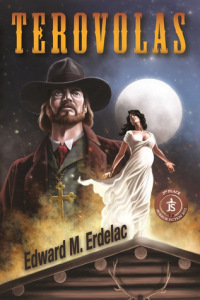 November will see the release of my latest book, Terovolas, from JournalStone Publishing, which placed third in their annual advance contest.
November will see the release of my latest book, Terovolas, from JournalStone Publishing, which placed third in their annual advance contest.
Following the events of Bram Stoker’s Dracula and his killing of the nefarious count’s vampiric wives, Professor Abraham Van Helsing commits himself to Dr. John Seward’s Purfleet Asylum, suffering from violent recurring fantasies, where he is diagnosed with melancholic lycanthropia.
Upon his discharge, seeking a relaxing holiday, Van Helsing volunteers to transport the remains and earthly effects of Quincey P. Morris back to the Morris family ranch in Sorefoot, Texas. But when he arrives, he finds Quincey’s brother Cole embroiled in escalating tensions with a neighboring outfit of Norwegian cattle ranchers led by the enigmatic Sig Skoll.
Men and animals start turning up dead and dismembered. Van Helsing suspects a preternatural culprit, but is a shapechanger really loose on the Texas plains, a murderous cult, or are the delusions of his previously disordered mind returning? He must decide soon, for the life of a woman may hang in the balance…
Here’s an excerpt -
From The Journal Of Professor Abraham Van Helsing(translated from the original Dutch)
5 July.
Thank God I am sane.
Those were the last words I wrote concerning my previous expedition to the Carpathian Mountains. How much has happened since I wrote those words, and in such a short time! Eight whole months have passed. Where to begin?
I will tell of how I came to be diagnosed with lycanthropy.
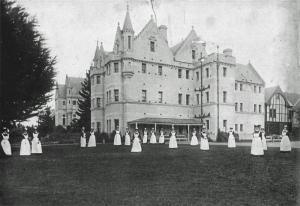 Following the series of events which took me away from my teaching at the University in Amsterdam to London, and at last to the mountainous region of Wallachia, I deemed it necessary that I should submit myself to the observation and care of my old friend Dr. John Seward in his asylum in Purfleet. The particulars of my stay I will not here recount. If John has learned anything from his old mentor it is the value of copious notation, and thus it would be mundane to relate here what has probably been more thoroughly documented on his phonographic records.
Following the series of events which took me away from my teaching at the University in Amsterdam to London, and at last to the mountainous region of Wallachia, I deemed it necessary that I should submit myself to the observation and care of my old friend Dr. John Seward in his asylum in Purfleet. The particulars of my stay I will not here recount. If John has learned anything from his old mentor it is the value of copious notation, and thus it would be mundane to relate here what has probably been more thoroughly documented on his phonographic records.
I know now that the specific reasons behind my decision were conceived in certain deeds which I was forced to commit in my pursuit of Count Dracula. In particular, I believe that the seed of my instability was planted by his wives – those three beauteous ladies with whom I dealt so harshly whilst they lay in their ghastly repose. I do not know how much of my current mental state is the product of whatever preternatural bewitchment almost stayed my hand in their execution, and how much is the perfectly logical after-effect of prolonged mental stress and fatigue.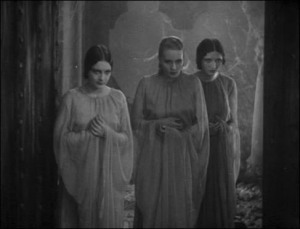
Whichever, not long after the funeral for our heroic Mr. Quincey Morris, I privately confided in John that I had begun to harbor some very unsettling, violent phantasies centering around our beloved Mrs.Mina Harker.
I was possessed of an unusually keen paranoia concerning her safety. I could not sleep for wont of assurance that she was at all times secure. I was at the Harkers’ nearly every day, and I am sorry to say I made quite a nuisance of myself. When at last Jonathan spoke frankly to me about my peculiar habit, I took to visiting the Harker home unannounced by night, watching from the silent shadows of the courtyard until the last lamps in the house were extinguished.
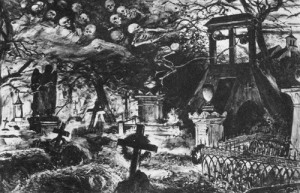 I would find myself passing cemeteries, which were not on my usual route. A ghoulish compulsion began to grow within me, that I should inter the graves within and subject the innocent corpses to the same maschalimos treatments I had prescribed for the vampires. I took to carrying my implements with me—my mallet and stakes, vials of blessed water, and garlic cloves. I knew the bodies in those plots were not the creatures that my imagination was telling me they were, and yet I was overwhelmed with a desire to do them violence.
I would find myself passing cemeteries, which were not on my usual route. A ghoulish compulsion began to grow within me, that I should inter the graves within and subject the innocent corpses to the same maschalimos treatments I had prescribed for the vampires. I took to carrying my implements with me—my mallet and stakes, vials of blessed water, and garlic cloves. I knew the bodies in those plots were not the creatures that my imagination was telling me they were, and yet I was overwhelmed with a desire to do them violence.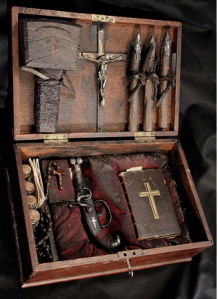
I also had terrible nightmares in which I would pry open the tomb of Miss Lucy Westenra-Holmwood, thinking to find Dracula’s favored bride there—the very lovely, dark haired one whose coffin had commanded such a special place in his ossuary. When I flung aside the sarcophagus however, it was always Miss Mina who would leap from the casket, slavering and hungry for my blood. Sometimes these terrors ended with my death. Quite a peculiar thing, for is it not speculated that those who die in dreams die in life? Other times, they ended with her’s—and if it was her’s, it was always a prolonged, bloody end, and my phantasmic alter ego would perform acts of lustful malice upon her too vile even to recount here.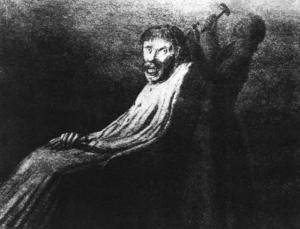
In a moment of clarity I saw that it would not be long before I was apprehended in the midst of some atrocity that would bring myself and my loved ones much shame. It was with no small relief that I surrendered the care of my body and mind to my friend John.
I have been on extended leave from my teaching for far too long, but I am grateful to the understanding of my colleagues, who have written me with assurances that I can return whenever I am able. It is good to feel needed.
I also take comfort now that I am once again the man that I was, and am pursuing an active role in my emotional convalescence. I feel that my return to these notes, which are evolving into a kind of journal, is somehow a part of it. John tells me that there was a time when I would place this book within a circle of holy water and bury it in sprigs of fresh cut roses, and cower in the corner of my room, not daring to look at it, fearing the entries scrawled within. I have no memory of this, and it seems humorous to me now that I should have been so foolish. I hope that John will share his documentation of my case with his grateful patient one day, if only to amuse an old man.
 It was John who diagnosed me with melancholic lycanthropia. I was of course already familiar with the condition. It has been in the physician’s lexicon since the fifth century, though with the advent of modern medicine and the eradication of humoral theory, the melancholic has been mostly done away with, leaving the lycanthropy (the Greek lykos –‘wolf’ and anthropos–‘man’) alone intact.
It was John who diagnosed me with melancholic lycanthropia. I was of course already familiar with the condition. It has been in the physician’s lexicon since the fifth century, though with the advent of modern medicine and the eradication of humoral theory, the melancholic has been mostly done away with, leaving the lycanthropy (the Greek lykos –‘wolf’ and anthropos–‘man’) alone intact.
In folklore of course, it is the name given to the werewolf—the man or woman who assumes the shape of a wolf, usually by night. The means by which this is achieved are numerous, and include everything from wolf-hide belts and imaginatively composed unguents, to the ubiquitous pact with Satan.
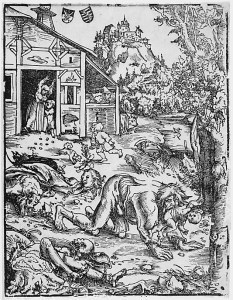 In psychiatric terms, lycanthropy refers to the belief of the patient that he or she assumes the form and characteristics of a wolf or other beast. This belief often translates itself into violent and in the extreme, even cannibalistic acts. While it was never in my mind (I do not think) that I should become a beast and eat the flesh of the living (or the dead), I do believe that the acts which I was contemplating were of a potentially bestial nature.
In psychiatric terms, lycanthropy refers to the belief of the patient that he or she assumes the form and characteristics of a wolf or other beast. This belief often translates itself into violent and in the extreme, even cannibalistic acts. While it was never in my mind (I do not think) that I should become a beast and eat the flesh of the living (or the dead), I do believe that the acts which I was contemplating were of a potentially bestial nature.
When John first brought his theory to me, I was reminded of the case of the soldier Bertrand, who in 1849 in France began his horrific career by strolling through cemeteries at night just as I had. Bertrand took to digging up and mutilating the bodies of young women and girls. It took a spring gun trap set into a freshly buried coffin to end his diabolical career at last. I did not want my ailment to progress so far as had Bertrand’s.
But these things are behind me now. The nightmares have ceased, and the barely controlled instincts have abated.
It is most ironic however, to have written this and now to have to tell that I am on a passenger steamer with only the remains of poor Quincey Morris for company.
But I must explain.
Having born the body of our dear Mr. Morris back to London after the end of our travails, it was mutually agreed that as our American friend had made no preparations for his sudden and regrettable departure from this earth, we should let Arthur Holmwood Lord Godalming, who was his eldest and closest friend, decide what should be done with him.
“He was a man at home in so many places, and yet…it seems to me that he should want to rest at home, in Texas. He spoke very fondly of his family’s ranch there. Yes. Texas, I should think.”
This was the proclamation I heard Lord Godalming give prior to my illness, and so far as I knew, it was carried out when I entered John’s care.
Yet when I emerged again, Mr. Morris was still in London, reposing in an urn on Lord Godalming’s mantle.
During my recuperation much had occurred in the life of Arthur Holmwood that did not allow sufficient time for a voyage to America. There were many decisions to be made regarding his late father’s estate. Not only were there a good deal of unforseen settlements to be arranged with his father’s creditors, but there was also the managing of the will and the mediation of rival inheritors who were not at all disposed in their shameful avarice to allot to the executor and chief heir time enough to mourn for both a fiancé and a best friend. A miser’s patience is truly as short as his compassion.
With John’s encouragement (he seemed to see in the hiatus some therapeutic value), I offered and was then granted the task of bearing the remains and worldly remembrances of Quincey P. Morris home to his native land, which lay in the Callahan County of Texas, United States American.
–
And here’s the unexpurgated cover art from the very talented Wayne Miller, which I think deserves a look…


Terovolas Giveaway On Goodreads
 November will see the release of my latest book, Terovolas, from JournalStone Publishing, which placed third in their annual advance contest. Head over here to Goodreads and you can enter for a chance to win one of ten free advance print copies, a full month before the book comes out.
November will see the release of my latest book, Terovolas, from JournalStone Publishing, which placed third in their annual advance contest. Head over here to Goodreads and you can enter for a chance to win one of ten free advance print copies, a full month before the book comes out.
Following the events of Bram Stoker’s Dracula and his killing of the nefarious count’s vampiric wives, Professor Abraham Van Helsing commits himself to Dr. John Seward’s Purfleet Asylum, suffering from violent recurring fantasies, where he is diagnosed with melancholic lycanthropia.
Upon his discharge, seeking a relaxing holiday, Van Helsing volunteers to transport the remains and earthly effects of Quincey P. Morris back to the Morris family ranch in Sorefoot, Texas. But when he arrives, he finds Quincey’s brother Cole embroiled in escalating tensions with a neighboring outfit of Norwegian cattle ranchers led by the enigmatic Sig Skoll.
Men and animals start turning up dead and dismembered. Van Helsing suspects a preternatural culprit, but is a shapechanger really loose on the Texas plains, a murderous cult, or are the delusions of his previously disordered mind returning? He must decide soon, for the life of a woman may hang in the balance…
Here’s an excerpt -
From The Journal Of Professor Abraham Van Helsing(translated from the original Dutch)
5 July.
Thank God I am sane.
Those were the last words I wrote concerning my previous expedition to the Carpathian Mountains. How much has happened since I wrote those words, and in such a short time! Eight whole months have passed. Where to begin?
I will tell of how I came to be diagnosed with lycanthropy.
 Following the series of events which took me away from my teaching at the University in Amsterdam to London, and at last to the mountainous region of Wallachia, I deemed it necessary that I should submit myself to the observation and care of my old friend Dr. John Seward in his asylum in Purfleet. The particulars of my stay I will not here recount. If John has learned anything from his old mentor it is the value of copious notation, and thus it would be mundane to relate here what has probably been more thoroughly documented on his phonographic records.
Following the series of events which took me away from my teaching at the University in Amsterdam to London, and at last to the mountainous region of Wallachia, I deemed it necessary that I should submit myself to the observation and care of my old friend Dr. John Seward in his asylum in Purfleet. The particulars of my stay I will not here recount. If John has learned anything from his old mentor it is the value of copious notation, and thus it would be mundane to relate here what has probably been more thoroughly documented on his phonographic records.
I know now that the specific reasons behind my decision were conceived in certain deeds which I was forced to commit in my pursuit of Count Dracula. In particular, I believe that the seed of my instability was planted by his wives – those three beauteous ladies with whom I dealt so harshly whilst they lay in their ghastly repose. I do not know how much of my current mental state is the product of whatever preternatural bewitchment almost stayed my hand in their execution, and how much is the perfectly logical after-effect of prolonged mental stress and fatigue.
Whichever, not long after the funeral for our heroic Mr. Quincey Morris, I privately confided in John that I had begun to harbor some very unsettling, violent phantasies centering around our beloved Mrs.Mina Harker.
I was possessed of an unusually keen paranoia concerning her safety. I could not sleep for wont of assurance that she was at all times secure. I was at the Harkers’ nearly every day, and I am sorry to say I made quite a nuisance of myself. When at last Jonathan spoke frankly to me about my peculiar habit, I took to visiting the Harker home unannounced by night, watching from the silent shadows of the courtyard until the last lamps in the house were extinguished.
 I would find myself passing cemeteries, which were not on my usual route. A ghoulish compulsion began to grow within me, that I should inter the graves within and subject the innocent corpses to the same maschalimos treatments I had prescribed for the vampires. I took to carrying my implements with me—my mallet and stakes, vials of blessed water, and garlic cloves. I knew the bodies in those plots were not the creatures that my imagination was telling me they were, and yet I was overwhelmed with a desire to do them violence.
I would find myself passing cemeteries, which were not on my usual route. A ghoulish compulsion began to grow within me, that I should inter the graves within and subject the innocent corpses to the same maschalimos treatments I had prescribed for the vampires. I took to carrying my implements with me—my mallet and stakes, vials of blessed water, and garlic cloves. I knew the bodies in those plots were not the creatures that my imagination was telling me they were, and yet I was overwhelmed with a desire to do them violence.
I also had terrible nightmares in which I would pry open the tomb of Miss Lucy Westenra-Holmwood, thinking to find Dracula’s favored bride there—the very lovely, dark haired one whose coffin had commanded such a special place in his ossuary. When I flung aside the sarcophagus however, it was always Miss Mina who would leap from the casket, slavering and hungry for my blood. Sometimes these terrors ended with my death. Quite a peculiar thing, for is it not speculated that those who die in dreams die in life? Other times, they ended with her’s—and if it was her’s, it was always a prolonged, bloody end, and my phantasmic alter ego would perform acts of lustful malice upon her too vile even to recount here.
In a moment of clarity I saw that it would not be long before I was apprehended in the midst of some atrocity that would bring myself and my loved ones much shame. It was with no small relief that I surrendered the care of my body and mind to my friend John.
I have been on extended leave from my teaching for far too long, but I am grateful to the understanding of my colleagues, who have written me with assurances that I can return whenever I am able. It is good to feel needed.
I also take comfort now that I am once again the man that I was, and am pursuing an active role in my emotional convalescence. I feel that my return to these notes, which are evolving into a kind of journal, is somehow a part of it. John tells me that there was a time when I would place this book within a circle of holy water and bury it in sprigs of fresh cut roses, and cower in the corner of my room, not daring to look at it, fearing the entries scrawled within. I have no memory of this, and it seems humorous to me now that I should have been so foolish. I hope that John will share his documentation of my case with his grateful patient one day, if only to amuse an old man.
 It was John who diagnosed me with melancholic lycanthropia. I was of course already familiar with the condition. It has been in the physician’s lexicon since the fifth century, though with the advent of modern medicine and the eradication of humoral theory, the melancholic has been mostly done away with, leaving the lycanthropy (the Greek lykos –‘wolf’ and anthropos–‘man’) alone intact.
It was John who diagnosed me with melancholic lycanthropia. I was of course already familiar with the condition. It has been in the physician’s lexicon since the fifth century, though with the advent of modern medicine and the eradication of humoral theory, the melancholic has been mostly done away with, leaving the lycanthropy (the Greek lykos –‘wolf’ and anthropos–‘man’) alone intact.
In folklore of course, it is the name given to the werewolf—the man or woman who assumes the shape of a wolf, usually by night. The means by which this is achieved are numerous, and include everything from wolf-hide belts and imaginatively composed unguents, to the ubiquitous pact with Satan.
 In psychiatric terms, lycanthropy refers to the belief of the patient that he or she assumes the form and characteristics of a wolf or other beast. This belief often translates itself into violent and in the extreme, even cannibalistic acts. While it was never in my mind (I do not think) that I should become a beast and eat the flesh of the living (or the dead), I do believe that the acts which I was contemplating were of a potentially bestial nature.
In psychiatric terms, lycanthropy refers to the belief of the patient that he or she assumes the form and characteristics of a wolf or other beast. This belief often translates itself into violent and in the extreme, even cannibalistic acts. While it was never in my mind (I do not think) that I should become a beast and eat the flesh of the living (or the dead), I do believe that the acts which I was contemplating were of a potentially bestial nature.
When John first brought his theory to me, I was reminded of the case of the soldier Bertrand, who in 1849 in France began his horrific career by strolling through cemeteries at night just as I had. Bertrand took to digging up and mutilating the bodies of young women and girls. It took a spring gun trap set into a freshly buried coffin to end his diabolical career at last. I did not want my ailment to progress so far as had Bertrand’s.
But these things are behind me now. The nightmares have ceased, and the barely controlled instincts have abated.
It is most ironic however, to have written this and now to have to tell that I am on a passenger steamer with only the remains of poor Quincey Morris for company.
But I must explain.
Having born the body of our dear Mr. Morris back to London after the end of our travails, it was mutually agreed that as our American friend had made no preparations for his sudden and regrettable departure from this earth, we should let Arthur Holmwood Lord Godalming, who was his eldest and closest friend, decide what should be done with him.
“He was a man at home in so many places, and yet…it seems to me that he should want to rest at home, in Texas. He spoke very fondly of his family’s ranch there. Yes. Texas, I should think.”
This was the proclamation I heard Lord Godalming give prior to my illness, and so far as I knew, it was carried out when I entered John’s care.
Yet when I emerged again, Mr. Morris was still in London, reposing in an urn on Lord Godalming’s mantle.
During my recuperation much had occurred in the life of Arthur Holmwood that did not allow sufficient time for a voyage to America. There were many decisions to be made regarding his late father’s estate. Not only were there a good deal of unforseen settlements to be arranged with his father’s creditors, but there was also the managing of the will and the mediation of rival inheritors who were not at all disposed in their shameful avarice to allot to the executor and chief heir time enough to mourn for both a fiancé and a best friend. A miser’s patience is truly as short as his compassion.
With John’s encouragement (he seemed to see in the hiatus some therapeutic value), I offered and was then granted the task of bearing the remains and worldly remembrances of Quincey P. Morris home to his native land, which lay in the Callahan County of Texas, United States American.
–
And here’s the unexpurgated cover art from the very talented Wayne Miller, which I think deserves a look…
The giveaway ends October 1st, so go give it a shot.


September 12, 2012
Dubaku: An Excerpt
It occurred to me that I began this blog long after my first work was ever published, so I’ve never written about my debut novella, Dubaku from Damnation Books.
Ah well, better late than never.
In 1760 somewhere near the Bight Of Benin, Dubaku, a powerful African shaman belonging to an obscure interior tribe (the Waziri, whom certain readers may be familiar with by name) surrenders himself willingly to an English slaving expedition.
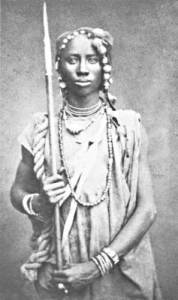 Dubaku has come in search of his wife Zuberi, an Aja warrior woman of the Dahomey Amazons, abducted and sold to another party of whites by her brother for marrying Dubaku in place of Mwenye’s best friend, to whom she was betrothed. Not knowing one ship from another, Dubaku boards the slaver hoping to find her.
Dubaku has come in search of his wife Zuberi, an Aja warrior woman of the Dahomey Amazons, abducted and sold to another party of whites by her brother for marrying Dubaku in place of Mwenye’s best friend, to whom she was betrothed. Not knowing one ship from another, Dubaku boards the slaver hoping to find her.
The captain, a cruel and careless man named Bryce, mistrusts Dubaku and his imperious bearing immediately, and when a rampant sickness takes its toll on the superstitious crew and their human cargo midway through the voyage to Jamaica, Bryce decides to offer up the shaman to the sea as their Jonah.
But when a violent squall drowns the entire compliment of would-be slaves, Dubaku calls upon dark and terrible powers to enact a fitting vengeance on Captain Bryce and his men.
Dubaku is a work of horror fiction, but like much of the horror I write, the most heinous parts are true. If there ever was a more reprehensible and morally depraved institution as human chattel slavery (in all its forms, many of which continue to this very day), I haven’t seen it yet, and hope I never do.
Writing Dubaku changed my life, as it was my first published standalone work. But researching it was a harrowing experience in and of itself. There is a horror and there is Horror, and the latter has nothing to do with zombies and everything to do with men who ignore the basic human rights of their fellow men.
Here’s an excerpt -
Dubaku had seen strange things in his journeys. He had trucked with spirits under the tutelage of Subira. The deep magic of his father’s people was now married to the wild rituals of Vodoun in his heart. As the dirty fat man prodded him and the other Aja into the waiting boat, he touched the concealed packet he had brought with him, and it was as though he could feel the magic of its contents throbbing like a living heart. He prayed to the Dahomey lwa and to the spirits of his ancestors and to the deepest Waziri powers he knew of that he had all he needed, and that the whites would not discover it.
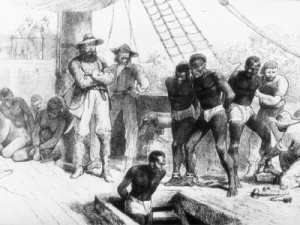 They were brought to the tall ship, men, women, and children, most too stunned by their capture to fight or protest. They were roughly ushered onto the decks and herded into pairs, where a blue-armed man fit shackles about their ankles and ran long lengths of chain through them. Next, a dented tin pannikin was jammed into their tremulous hands. A disinterested sailor sloppily ladled water from a barrel into it, which mattered little as their shaking and the jostling of the bodies meant that they spilled most of it anyway.
They were brought to the tall ship, men, women, and children, most too stunned by their capture to fight or protest. They were roughly ushered onto the decks and herded into pairs, where a blue-armed man fit shackles about their ankles and ran long lengths of chain through them. Next, a dented tin pannikin was jammed into their tremulous hands. A disinterested sailor sloppily ladled water from a barrel into it, which mattered little as their shaking and the jostling of the bodies meant that they spilled most of it anyway.
Then the hatch was thrown open, and for the Aja it was terrifying – like the wooden maw of a creaking, big bellied sea beast waking to swallow them whole. This beast breathed out a hot blast of putrid stink – the noisome smell of sweat and excrement and death and sickness, like the breath of some pestilential entity native to the inferno.
There was no light down below, only the shaky glow of the whale oil lamps the sailors lit and carried with them. The Aja were pushed and pulled down into the deceptively cavernous mouth, and there found that in fact there was no room at all.
Waves of them were force-fed into the ship’s groaning timber bowels. The swinging light of the lamps cast a faltering glow on the floor, which was carpeted in row upon row of swooning black bodies. They tread upon the bare skin of exhausted figures who recoiled at their touch or else lay in the stiff cold of death, bones snapping beneath their collective weight. Women whimpered and clutched at each other, and the weeping of the children was redoubled.
What was this strange precinct of hell into which they had been brought? What cave, carpeted in barely perceived forms that shifted and struck out like irritated sleepers? Chains clinked and voices moaned, begging for water and gripping at the pantaloons of the white men only to be clouted down. Others pulled the water tins away from the newcomers and avariciously sucked the precious wetness from them in the dark.
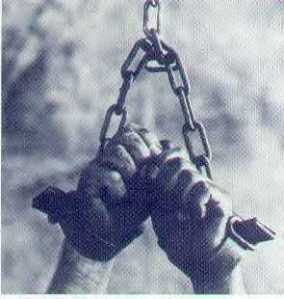 It was hot from the press of the bodies. Bodies, all around, stretching on down the dark passage. They could not step without treading upon another or slipping in drek and waste. Still, they were pulled through the utter darkness by the hunched over sailors, and now some pairs were yanked down and told to sit with their knees up against their chest. They found that their allotted space was very little, and they were pressed on every side by slaves sitting in the same posture so that they could not shift at all for want of comfort. Unfamiliar heads lolled against them on exhausted necks. Crowds of biting lice jumped from their neighbors onto their skin as soon as they settled, and this could not be helped.
It was hot from the press of the bodies. Bodies, all around, stretching on down the dark passage. They could not step without treading upon another or slipping in drek and waste. Still, they were pulled through the utter darkness by the hunched over sailors, and now some pairs were yanked down and told to sit with their knees up against their chest. They found that their allotted space was very little, and they were pressed on every side by slaves sitting in the same posture so that they could not shift at all for want of comfort. Unfamiliar heads lolled against them on exhausted necks. Crowds of biting lice jumped from their neighbors onto their skin as soon as they settled, and this could not be helped.
Their chains were run through iron rungs in the floor and they could not stand. Some tried when the slavers moved on with the others, only to dash their heads on the low ceiling and fall back down senseless.
Dubaku and another man were the last. They stood listening to the commotion below the deck until the last of the hundred Aja had been packed in. The sailors tore away Dubaku’s cloak and necklace.
They fitted them both with chains and Dubaku stared up the tall mast at the sky, which was filled with crying, wheeling gulls, and prayed Zuberi was alive and wherever they were bound. The man beside him trembled and wept. Urine rained down his bare legs and splashed Dubaku’s foot. The white men jeered and kicked them both, until the little captain climbed aboard and told them to cease.
The little captain stood before him and smiling, nodded to the fat man, who took up a lantern. Dubaku and his partner were seized and taken down below deck, amid the chaos that therein dwelt. Some tried to take his sloshing pannikin, but he slapped them away. Dubaku heard the voice of the fat man close, and felt a hairy fist strike his lips. They forced him to sit and chained him to the floor. He tasted blood.
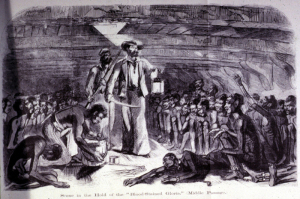 He watched the bulky shadow of the fat man and his lamp make its way back toward the faraway square of fading light that shone down the hatch through which they’d passed. The fat man went up the ladder and in a moment the hatch slammed shut. They were all in complete darkness and some screamed louder than before. He tried to yell above them, tried to bring order somehow, but it was useless. They babbled in a half dozen languages of which he mostly knew nothing.
He watched the bulky shadow of the fat man and his lamp make its way back toward the faraway square of fading light that shone down the hatch through which they’d passed. The fat man went up the ladder and in a moment the hatch slammed shut. They were all in complete darkness and some screamed louder than before. He tried to yell above them, tried to bring order somehow, but it was useless. They babbled in a half dozen languages of which he mostly knew nothing.
He touched his forehead to his knees as the vermin, emboldened by the reinforcement of the shadow, began to scuttle over his feet. He prayed once more to all the lwa that his wife and child lived somewhere.
—
What some people said of Dubaku -
‘The suspense and pace of the story never relents…the pace is incredibly fast and the scare is compacted into a few short bloody pages to create a
heart-pounding read.’ –Kelly Fann, Monsterlibrarian.com
‘Erdelac has written a haunting novella filled with magic (both black and white), death and humanity. For in the end it is all about what humanity really is, and whether or not God or Gods listen to prayers and answer them.’ –Bitten By Books
‘Erdelac’s voodoo-tinged revenge tale features…a “Death Ship” scenario that makes the “Death Ship” films look like unaired episodes of The Love Boat.’ – The Horror Fiction Review
You can pick it up from Damnationbooks.com or here at Amazon in print or Kindle -


August 31, 2012
Fade To Black: Theophany Of Nyx in Fading Light: An Anthology Of The Monstrous
Today Fading Light: An Anthology Of The Monstrous is out from Angelic Knight Press and editor (and friend) Tim Marquitz, author of the Dawn of War series (and editor on two of my Merkabah Rider books).
The concept behind Fading Light is pretty cool.
(from the back cover)
“The light has failed: the era of man is at its end.
Born of darkness, the creatures of myth, legend, and nightmare have long called the shadows home. Now, with the cruel touch of the sun fading into memory, they’ve returned to claim their rightful place amidst humanity: as its masters.”
The stories are by Mark Lawrence, Gene O’Neill, William Meikle, David Dalglish, Gord Rollo, Nick Cato, Adam Millard, Stephen McQuiggan, Gary W Olson, Tom Olbert, Malon Edwards, Carl Barker, Jake Elliot, Lee Mather, Georgina Kamsika, Dorian Dawes, Timothy Baker, DL Seymour, Wayne Ligon, TSP Sweeney, Stacey Turner, Gef Fox, Henry P Gravelle, & Ryan Lawler.
My own contribution, The Theophany of Nyx, came to me while watching one of the many Nova and National Geographic specials my wife subjects me to on a regular basis on Netflix Instant.
This one was on the formation of the moon, and in particular, the current popular theory that it was formed when a hurtling celestial body called Theia struck the earth about 4.5 billion years ago and blew a chunk of the earth into its own orbit.
It’s a cool little theory. You can read about it here…
http://en.wikipedia.org/wiki/Giant_impact_hypothesis
 In my story, which takes place in an unspecified future, Selene, the first lunar colony, is established on the moon with much fanfare. But the greatest achievement of mankind swiftly becomes its greatest tragedy when a crack opens in the moon’s surface and Selene slips inside, causing a billowing cloud of sublunar dust to spread into the earth’s atmosphere, blotting out the sun.
In my story, which takes place in an unspecified future, Selene, the first lunar colony, is established on the moon with much fanfare. But the greatest achievement of mankind swiftly becomes its greatest tragedy when a crack opens in the moon’s surface and Selene slips inside, causing a billowing cloud of sublunar dust to spread into the earth’s atmosphere, blotting out the sun.
Plants begin to die, and at the Ft. Sill army base in Oklahoma, bored contract plumber Walter Coombs finds himself stuck on lockdown, a captive audience slowly watching the whole thing unfold.
Then one night a rain begins to fall, and the soldiers hold an impromptu football game to celebrate what they assume will break up the impenetrable cloud.

Don’t go out in the rain.
But the rain carries something exiled to the moon in the prehistoric cosmic wars that once raged across the surface of the fledgling earth. Something that is returning to reclaim its ancentral home…
So borrowing heavily from Nova, Dr. Reginald Aldworth Daly, and the writings of H.P. Lovecraft, comes The Theophany of Nyx.
Pick up a copy of Fading Light and check it out – http://www.amazon.com/Fading-Light-Anthology-Monstrous-ebook/dp/B0094IC60G/ref=sr_1_5?ie=UTF8&qid=1346459952&sr=8-5&keywords=fading+light+anthology
Hasta pronto!


August 25, 2012
DT Moviehouse Review: Attack The Block
Time once more for my blog feature, DT Moviehouse Reviews, in which I make my way alphabetically through my 200+ DVD/Blu-Ray collection (you can see the list right here) and decide if each one was worth the money. Today I take another look at Joe Cornish’s sci-fi horror comedy/inner city mash up Attack The Block.

(2011) Written and Directed by Joe Cornish
Tagline: Inner City vs. Outer Space
What it’s about:
The mugging of Sam, a young nurse (Jodie Whittaker), by a tight knit clique of masked inner city kids from a high rise South London housing project on the night of the Guy Fawkes holiday is interrupted when an alien creature streaks out of the pyrotechnically-lit night sky and smashes into the roof of a parked car. The teenaged leader of the group, Moses (the arresting young John Boyega), scuffles with and winds up killing the creature, which the boys then stash with the local weed grower (Nick Frost), unaware that their block is about to come under attack by a legion of similar critters, ravenous males attracted by the scent of the dead female.
Why I bought it:
This was the most entertaining, original movie I saw in 2011. I loved it.
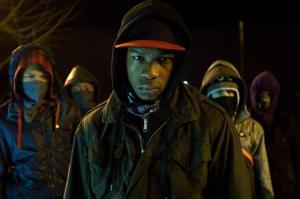 It’s an 80’s style Goonies adventure mixed with John Carptenter-esque horror and action (plus a generous dose of humor, gallows and otherwise), and starring a winsome young cast as modern inner city kids who begin the movie not entirely likeable, but redeem themselves and take on heroic traits by the end.
It’s an 80’s style Goonies adventure mixed with John Carptenter-esque horror and action (plus a generous dose of humor, gallows and otherwise), and starring a winsome young cast as modern inner city kids who begin the movie not entirely likeable, but redeem themselves and take on heroic traits by the end.
I hate do this, but I feel the need to address something. In preparing to write this review, I took a look at imdb to refresh myself on the actors’ names, and was amazed to see it had only a 6.7 rating. Baffled, I scrolled down to the comments for an explanation, and was appalled to find an unfortunate number of thinly disguised racist viewpoints. Many viewers declare the kids to be entirely unrelatable either due to their accent and slang (patois, they might as well say), their attitudes, or their lifestyle. Some say the kids hooligan-esque behavior is actually glorified, and that they’re static and unlikeable.
I have no idea what movie these people were watching. I frankly think they folded their arms at the opening scene and judged the characters by their mannerisms and appearances, and never gave the movie a chance after that. This is unfortunate, because they missed a great, fun movie.
I think depicting the main characters as hoodlums in the beginning was an infinitely more interesting choice than populating this movie with the tired, unimaginative trope of inoffensive white suburban kids. The setting, the characters, they’re what makes Attack The Block special. Reasoning through the accents and the fascinating slang is part of the fun of it. I’d liken it to the experience of watching A Clockwork Orange the first time, a film whose characters are inarguably less likeable and relatable and whose actions are ten times more heinous than anything any kid in Attack The Block does (and whose slang is much more puzzling if you haven’t read the book).
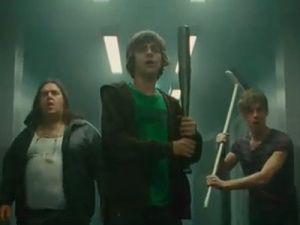 And seriously, are Moses and his friends really the badass gangstas they appear to be in the opening scene? If you can watch this and honestly say yes, holy crap I hope you never come face to face with an honest to God hoodlum. I mean come on, when the kids are gathering their ‘weapons’ (mostly fireworks and samurai swords – not a real pistol among them, I actually think the Frog Brothers were able to assemble a deadlier arsenal in Lost Boys) Dennis (Franz Drameh)’s parent hollers for him to walk the dog AND HE DOES. Pest (Alex Esmail) wants to lock himself in his room and play FIFA on Xbox. Not really a bunch of hardened criminals, these guys.
And seriously, are Moses and his friends really the badass gangstas they appear to be in the opening scene? If you can watch this and honestly say yes, holy crap I hope you never come face to face with an honest to God hoodlum. I mean come on, when the kids are gathering their ‘weapons’ (mostly fireworks and samurai swords – not a real pistol among them, I actually think the Frog Brothers were able to assemble a deadlier arsenal in Lost Boys) Dennis (Franz Drameh)’s parent hollers for him to walk the dog AND HE DOES. Pest (Alex Esmail) wants to lock himself in his room and play FIFA on Xbox. Not really a bunch of hardened criminals, these guys.
Yes some of the kids smoke weed and idolize a gangster (Hi-Hatz, played very well by Jumayn Hunter. And really, though he does carry a gun, he’s not one of the boys, and he’s something of a fool. It cracks me up that he takes every opportunity to play and rap along to his own demo tape –Get the weed! Get the strap! Don’t give a fuck! BLAP BLAP BLAP!), but unlikeable? They display the same camaraderie and regard for each other as The Goonies (see how the kids refuse to abandon Moses even when he’s nabbed by a couple of cops), and though their world view is skewed, it makes perfect sense in the context of their environment. I think a great example of that is when they burst into Sam’s apartment and are amazed to find her there, at one point admitting (to her exasperation) that if they knew she was from the block, they never would’ve mugged her.
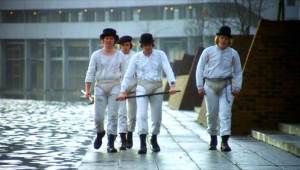
I would rather run into any of the ATB kids than one of these guys on the streets of South London.
To put it another way, I can name any number of extremely popular movies where the main characters are a thousand times more terrible than these kids. How about Scarface? The Godfather Trilogy? And yet, these characters are generally beloved by cinephiles when for the most part, they don’t even seek redemption let alone find it. But…they’re white.So what’s really going on here?
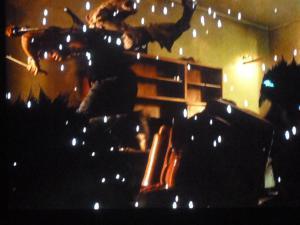 As to the characters being static, the movie plainly states its thesis of actions have consequences. Moses’ killing of the female alien is what sparks the attack on the block, and it can be inferred, the deaths of several people, including his friends. And Moses plainly reasons this out and is pained by it. In the end he accepts responsibility for it – quite literally when he acts as bait to ultimately destroy the things.
As to the characters being static, the movie plainly states its thesis of actions have consequences. Moses’ killing of the female alien is what sparks the attack on the block, and it can be inferred, the deaths of several people, including his friends. And Moses plainly reasons this out and is pained by it. In the end he accepts responsibility for it – quite literally when he acts as bait to ultimately destroy the things.
It’s very telling that of the three characters the police arrest and escort out of the block (Brewis, Pest, and finally Moses) at the end, Moses is the only that doesn’t resist or cause a scene.
Finally, as to the lifestyles of the kids being glorified, I can think of no more poignant moment in the film than when Sam sees the disarray of Moses’ apartment (trash and old pizza boxes etc), and upon seeing his Spider-Man bed sheets asks him if he has a little brother, to which he obliviously replies no. Is this a glorification of Moses’ lifestyle? Didn’t seem very glorious to me. Not a tiger or a room sized bathtub or a desk with a mountain of cocaine in sight.
But enough response to criticisms, more on what I love about this movie.
The soundtrack is excellent, with the main title theme like a hip-hop version of 1950’s space invasion Theremin music, to say nothing of the inclusion of some great head bobbing tracks like KRS One’s classic Sound Of Da Police.
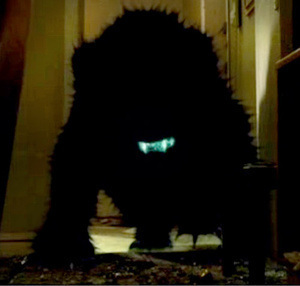 The performances are without a weak point, from the brilliant kids (what a windfall Cornish had in finding such a talented group of youngsters!) to Luke Treadway’s twitchy well-to-do and sorely out of place pot buyer Brewis, Nick Frost’s schlubby, cowardly weed dealer Ron (“Maybe there was a party at the zoo and a monkey fucked a fish,” he thoughtfully observes upon first seeing the dead alien), and the two eight year old wannabes who tag along like anxious puppies and insists on being called Mayhem and Probs (“Nobody’s ever gonna call you Mayhem if you don’t stop acting like such a pussy!”).
The performances are without a weak point, from the brilliant kids (what a windfall Cornish had in finding such a talented group of youngsters!) to Luke Treadway’s twitchy well-to-do and sorely out of place pot buyer Brewis, Nick Frost’s schlubby, cowardly weed dealer Ron (“Maybe there was a party at the zoo and a monkey fucked a fish,” he thoughtfully observes upon first seeing the dead alien), and the two eight year old wannabes who tag along like anxious puppies and insists on being called Mayhem and Probs (“Nobody’s ever gonna call you Mayhem if you don’t stop acting like such a pussy!”).
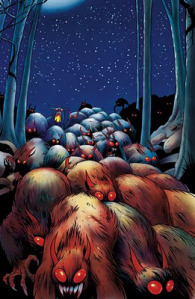 The aliens are minimalist and cool, nothing more than featureless, (with the help of CGI) blacker than black “hairy gorilla-wolf motherfuckers” with rows of blue luminous teeth. They reminded me of the rat creatures from Jeff Smith’s Bone. Their locomotion, a sort of high speed primate lope, is particularly cool and harrowing.
The aliens are minimalist and cool, nothing more than featureless, (with the help of CGI) blacker than black “hairy gorilla-wolf motherfuckers” with rows of blue luminous teeth. They reminded me of the rat creatures from Jeff Smith’s Bone. Their locomotion, a sort of high speed primate lope, is particularly cool and harrowing.
The violence is gory and shocking, and the kids aren’t spared because of their tender age. But don’t get me wrong, the movie is also hilarious. The dialogue is fresh and funny, with much of the situational humor just coming from the interactions. Brewis’ attempts to be ‘cool’ with the kids are great, and make their eventual acceptance of him endearing.
I think if you enjoyed Shaun Of The Dead (and if you didn’t, just stop reading this page and go watch Zack Snyder’s terrible Dawn Of The Dead remake or something), you’ll enjoy it.
Best bit of dialogue:
After their initial contact with the savage blue toothed aliens, Jerome (Leeon Jones) announces his intent to send everybody warning texts, but sees his prepaid is down to one text.
He bemoans;
“I’ve only got one text left! It’s too much madness for one text!”
Best scene:
Early in the film, Brewis waits for the elevator only to have Moses and the boys show up as the doors open. He stammers, “I’ll catch the next one then, shall I?” as the boys impassively shrug past him and get on, leaving him standing.
Much later, after the alien attack is in full swing, Hi-Hatz and his two armed cronies wind up being chased into the elevator by one of the aliens. The door closes and the car descends, multiple gunshots, screams, and alien screeches the only hint we get of what’s happening.
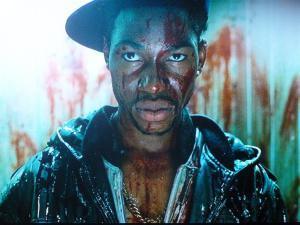
“Better take the next one, blood.”
Brewis has just found his wrecked car (it’s the very same car the first alien crash landed on) and paranoid at the heavy ‘po-po’ presence, is returning to the safety of Ron’s. He approaches the elevator just as the door opens.
The interior of the elevator is a veritable abbatoir, blood splashed and loaded with corpses.
Hi-Hatz emerges, drenched in blood.
“Better get the next one, blood,” he says, and walks by, leaving Brewis dumbfounded.
NEXT IN THE QUEUE: The Back To The Future Trilogy


August 24, 2012
Buff Tea Giveaway Is Ending
Last chance to enter for a chance to win a signed copy of Buff Tea, my coming of age western novel from Texas Review Press (via Goodreads).
http://www.goodreads.com/giveaway/show/28249-buff-tea
Giveaway ends sometime Saturday.
You can read all about the book here, including an excerpt…
http://emerdelac.wordpress.com/2011/06/11/buff-tea-an-excerpt/


August 19, 2012
Happy Birthday H.P. Lovecraft
Today marks the birthday of Howard Philips Lovecraft.
I was asked to do a birthday post for old HPL over at Fantasy Book Review.
http://www.fantasybookreview.co.uk/fbrblog/edward-m-erdelac-happy-birthday-h-p-lovecraft/


August 17, 2012
Plastic Man and Mr. Fantastic have foolproof superpowers….what do you think?
Gef Fox’s final Corrupts Absolutely roundtable discussion ends with talk of superpowers and showdowns. Take a look.
http://networkedblogs.com/B4AeY



